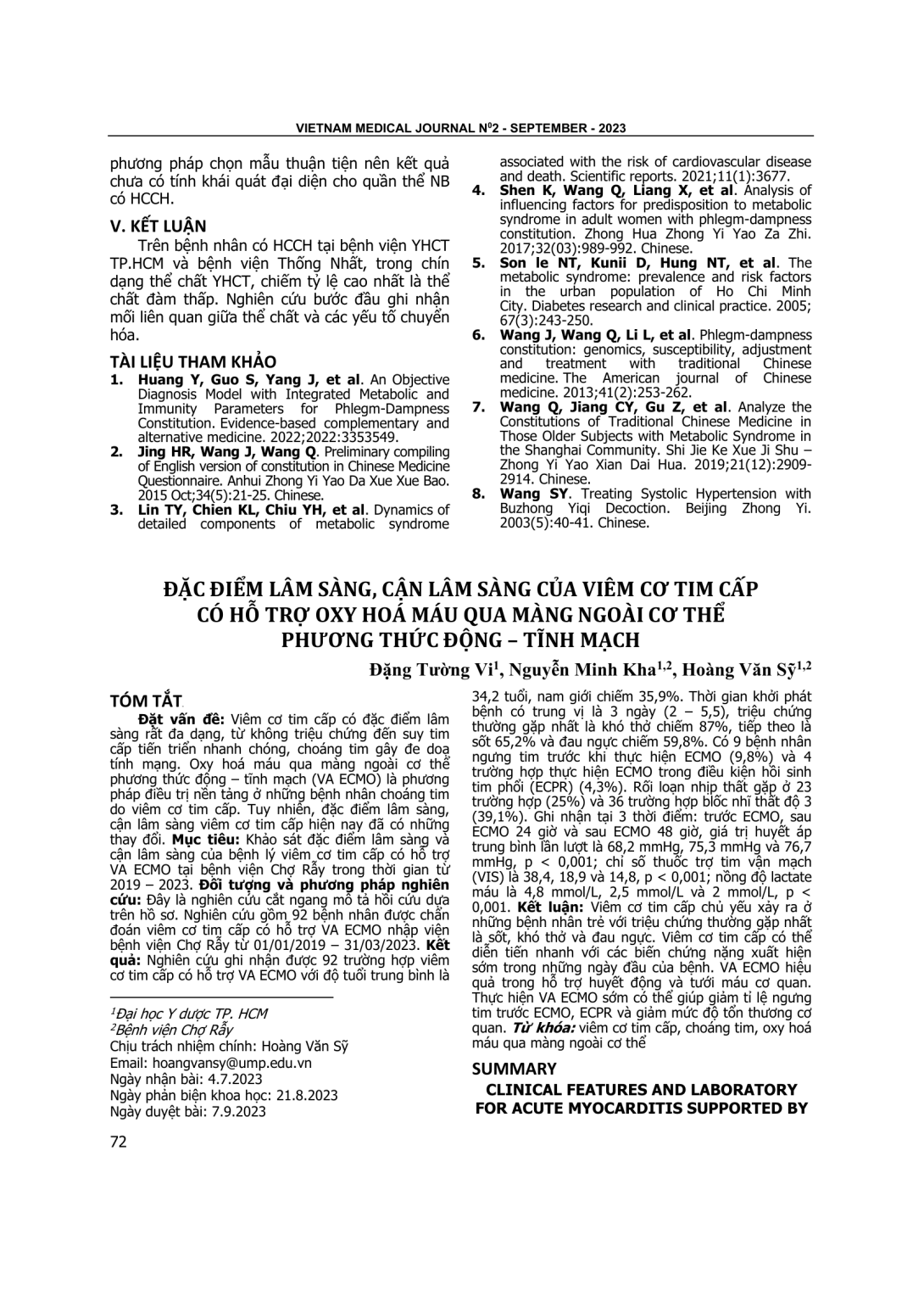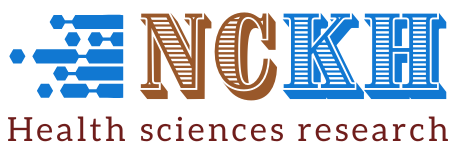
Viêm cơ tim cấp có đặc điểm lâm sàng rất đa dạng, từ không triệu chứng đến suy tim cấp tiến triển nhanh chóng, choáng tim gây đe doạ tính mạng. Oxy hoá máu qua màng ngoài cơ thể phương thức động – tĩnh mạch (VA ECMO) là phương pháp điều trị nền tảng ở những bệnh nhân choáng tim do viêm cơ tim cấp. Tuy nhiên, đặc điểm lâm sàng, cận lâm sàng viêm cơ tim cấp hiện nay đã có những thay đổi. Mục tiêu: Khảo sát đặc điểm lâm sàng và cận lâm sàng của bệnh lý viêm cơ tim cấp có hỗ trợ VA ECMO tại bệnh viện Chợ Rẫy trong thời gian từ 2019 – 2023. Đối tượng và phương pháp nghiên cứu: Đây là nghiên cứu cắt ngang mô tả hồi cứu dựa trên hồ sơ. Nghiên cứu gồm 92 bệnh nhân được chẩn đoán viêm cơ tim cấp có hỗ trợ VA ECMO nhập viện bệnh viện Chợ Rẫy từ 01/01/2019 – 31/03/2023. Kết quả: Nghiên cứu ghi nhận được 92 trường hợp viêm cơ tim cấp có hỗ trợ VA ECMO với độ tuổi trung bình là 34,2 tuổi, nam giới chiếm 35,9%. Thời gian khởi phát bệnh có trung vị là 3 ngày (2 – 5,5), triệu chứng thường gặp nhất là khó thở chiếm 87%, tiếp theo là sốt 65,2% và đau ngực chiếm 59,8%. Có 9 bệnh nhân ngưng tim trước khi thực hiện ECMO (9,8%) và 4 trường hợp thực hiện ECMO trong điều kiện hồi sinh tim phổi (ECPR) (4,3%). Rối loạn nhịp thất gặp ở 23 trường hợp (25%) và 36 trường hợp blốc nhĩ thất độ 3 (39,1%). Ghi nhận tại 3 thời điểm: trước ECMO, sau ECMO 24 giờ và sau ECMO 48 giờ, giá trị huyết áp trung bình lần lượt là 68,2 mmHg, 75,3 mmHg và 76,7 mmHg, p < 0,001; chỉ số thuốc trợ tim vận mạch (VIS) là 38,4, 18,9 và 14,8, p < 0,001; nồng độ lactate máu là 4,8 mmol/L, 2,5 mmol/L và 2 mmol/L, p < 0,001. Kết luận: Viêm cơ tim cấp chủ yếu xảy ra ở những bệnh nhân trẻ với triệu chứng thường gặp nhất là sốt, khó thở và đau ngực. Viêm cơ tim cấp có thể diễn tiến nhanh với các biến chứng nặng xuất hiện sớm trong những ngày đầu của bệnh. VA ECMO hiệu quả trong hỗ trợ huyết động và tưới máu cơ quan. Thực hiện VA ECMO sớm có thể giúp giảm tỉ lệ ngưng tim trước ECMO, ECPR và giảm mức độ tổn thương cơ quan.
Acute myocarditis presents with a wide range of clinical features, from asymptonmatic to rapidly progressing acute heart failure, resulting in cardiogenic shock and life-threatening conditions. Venoarterial extracorporeal menbrane oxygenation (VA ECMO) serves as the cornerstone treatment for patients experiencing cardiogenic shock due to acute myocarditis. However, there have been changes in the clinical characteristics, laboratory findings of acute myocarditis with VA ECMO support. Objective: To describe the clinical features and laboratory findings of patients with acute myocarditis who were treated with veno – arterial extracorporeal membrane oxygenation at Cho Ray Hospital from 2019 to 2023. Patients and methods: A descriptive cross-sectional retrospective study. This study included 92 patients who diagnosed acute myocarditis and treated with extracorporeal membrane oxygenation at Cho Ray Hospital from January 2019 to March 2023. Results: The study recorded 92 cases of acute myocarditis with VA ECMO support, with a mean age of 34.2 years and males accounting for 35.9%. The median onset time of the disease was 3 days (2 - 5.5), with the most common symptoms being dyspnea (87%), followed by fever (65.2%) and chest pain (59.8%). Nine patients experienced cardiac arrest before ECMO implementation (9.8%), and four cases underwent ECMO during cardiopulmonary resuscitation (ECPR) (4.3%). Ventricular arrhythmia occurred in 23 cases (25%), and third-degree atrioventricular block was observed in 36 cases (39.1%). Measurements were recorded at three time points: before ECMO, 24 hours after ECMO, and 48 hours after ECMO. The mean blood pressure values were 68 mmHg, 75.3 mmHg, and 76.7 mmHg, respectively (p < 0.001). The vasoactive inotropic score (VIS) was 38.4, 18.9, and 14.8, respectively (p < 0.001). Blood lactate levels were 4.8 mmol/L, 2.5 mmol/L, and 2 mmol/L, respectively (p < 0.001). Conclusion: Acute myocarditis primarily affect young individuals with the most common symptoms including fever, dyspnea, and chest pain. Acute myocarditis can progress rapidly, characterized by the early onset of severe complications within the initial days of the disease. VA ECMO is effective in providing hemodynamic support and organ perfusion. Early initiation of VA ECMO can help reduce the incidence of cardiac arrest before ECMO and ECPR, and decrease organ injury severity.
- Đăng nhập để gửi ý kiến
